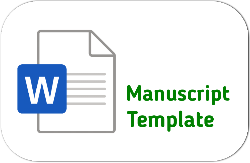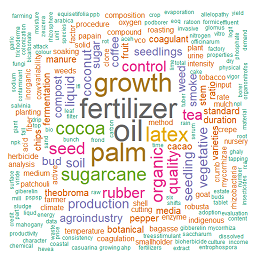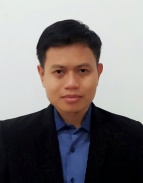Pengaruh Iklim terhadap Produksi Kakao di Kabupaten Gunungkidul
DOI:
https://doi.org/10.25181/jaip.v10i1.2370Keywords:
climate, cocoa production, rainfall, rainy day, temperatureAbstract
Cocoa is one of the commodities as a foreign exchange earner in addition to oil and gas. However, Indonesian cocoa imports have increased from year to year due to low cocoa productivity. Whereas in terms of region, Indonesia has the potential to become a new cocoa power country in the world of cocoa production. This study examines the effect of rainfall, the number of rainy days, and air temperature on cocoa production in the Gunungkidul district. This study uses a quantitative descriptive method. The data used in this study is secondary data in the form of time series data on rainfall, rainy days, air temperature, and cocoa production in 2016-2020 in Gunungkidul Regency. The regression analysis results showed that all observed climatic factors such as rainfall, rainy days, and temperature did not have a significant effect on cocoa production in Gunungkidul Regency. However, the time-series data shows that the highest cocoa production was in October 2017 and November 2018 to January 2019, when rainfall and intensity (rainy days) began to increase. Meanwhile, the air temperature in Gunungkidul Regency for five years is around 24-26°C, which is the optimum temperature for cocoa growth. This study concludes that rainfall, rain intensity (rainy days), and temperature affect fluctuations in cocoa production.Downloads
References
Abdoellah, S. (2021). Analisis Kinerja dan Prospek Komoditas Kakao. RADAR: Opini Dan Analisis Perkebunan, 2(01). https://deplantation.com/wp-content/uploads/2021/01/RADAR-Vol02-No01-Februari-2021.pdf
Aziziah, S. A., & Setiawina, N. D. (2021). Analisis Pengaruh Produksi, Harga Dan Nilai Tukar Terhadap Ekspor Biji Kakao Indonesia Ke Belanda. Cerdika: Jurnal Ilmiah Indonesia, 1(April), 448–455. http://cerdika.publikasiindonesia.id/index.php/cerdika/article/view/67
Bappeda Gunungkidul. (2022). Gambaran umum Kabupaten Gunungkidul. Gunungkidulkab.Go.Id. https://gunungkidulkab.go.id/D-74db63a914e6fb0f4445120c6fa44e6a-NR-100-0.html
BPS. (2019). Statistik Kakao Indonesia 2019. https://www.bps.go.id/publication/2020/12/02/2ac5a729f43e5f6b666e482d/statistik-kakao-indonesia-2019.html
BPS Gunung Kidul. (2020). Kabupaten Gunungkidul dalam Angka 2020. https://gunungkidulkab.bps.go.id/publication/2020/04/27/6830d4504d598ff400524bb1/kabupaten-gunungkidul-dalam-angka-2020.html
Dompreh, E. B., Asare, R., & Gasparatos, A. (2021). Sustainable but hungry? Food security outcomes of certification for cocoa and oil palm smallholders in Ghana. Environmental Research Letters, 16(5), 55001. https://doi.org/10.1088/1748-9326/ABDF88
Hadinata, S., & Marianti, M. M. (2020). Analisis Dampak Hilirisasi Industri Kakao di Indonesia. Jurnal Akuntansi, 12(1), 99–108. https://doi.org/10.28932/JAM.V12I1.2287
Hasanuddin, S. (2021). Analysis of Oil Palm Marketing Efficiency in Tommo District, Mamuju, Indonesia. Golden Ratio of Marketing and Applied Psychology of Business, 1(1), 01–13. https://doi.org/10.52970/GRMAPB.V1I1.55
Hutchins, A., Tamargo, A., Bailey, C., & Kim, Y. (2015). Assessment of Climate Change Impacts on Cocoa Production and Approaches to Adaptation and Mitigation: A Contextual View of Ghana and Costa Rica. https://elliott.gwu.edu/sites/g/files/zaxdzs2141/f/World Cocoa Foundation.pdf
Jacobi, J., Schneider, M., Bottazzi, P., Pillco, M., Calizaya, P., & Rist, S. (2015). Agroecosystem resilience and farmers’ perceptions of climate change impacts on cocoa farms in Alto Beni, Bolivia. Renewable Agriculture and Food Systems, 30(2), 170–183. https://doi.org/10.1017/S174217051300029X
Kindangen, H., Hartoyo, S., & Baga, L. M. (2017). Perkembangan Produktivitas, Luas Lahan, Harga Domestik, Permintaan dan Ekspor Biji Kakao Indonesia Periode 1990-2013. Jurnal Manajemen & Agribisnis, 14(2). https://doi.org/10.17358/JMA.14.2.118
Lawal, J. O., & Omonona, B. (2014). The effects of rainfall and other weather parameters on cocoa production in Nigeria. Comunicata Scientiae, 5(4), 518–523.
Manurung, M. T., Irsal, & Haryati. (2015). Pengaruh Curah Hujan dan Hari Hujan Terhadap Produksi Tanaman Karet. Jurnal Online Agroekoteknologi, 3(2), 564–573.
Najihah, T., Ibrahim, M., Hadley, P., & Daymond, A. (2018). The Effect of Different Day and Night Temperatures on the Growth and Physiology of Theobroma cacao under Controlled Environment Condition. Annual Research & Review in Biology, 27(2), 1–15. https://doi.org/10.9734/arrb/2018/40413
Ofori-Boateng, K., & Insah, B. (2014). The impact of climate change on cocoa production in West Africa. International Journal of Climate Change Strategies and Management, 6(3), 296–314. https://doi.org/10.1108/IJCCSM-01-2013-0007
Omolaja, S. S., Aikpokpodion, P., Oyedeji, S., & Vwioko, D. E. (2010). Rainfall and temperature effects on flowering and pollen productions in cocoa. African Crop Science Journal, 17(1), 41–48. https://doi.org/10.4314/acsj.v17i1.54209
Rahmanu, R. (2009). Analisis daya saing industri pengolahan dan hasil olahan kakao Indonesia. IPB (Bogor Agricultural University).
Rubiyo, & Siswanto. (2012). Peningkatan Produksi dan Pengembangan Kakao (Theobroma cacao L.) di Indonesia. Buletin RISTRI, 3(1), 33–48.
Sakti, G. P. (2016). Korelasi Suhu dan Curah Hujan terhadap Produksi Kakao (Theobroma cacao L) di Kebun Banjarsari PT Perkebunan Nusantara XII (Persero) Jember. Institut Pertanian Bogor.
Santosa, E., Sakti, G. P., Fattah, M. Z., Zaman, S., & Wahjar, A. (2018). Cocoa Production Stability in Relation to Changing Rainfall and Temperature in East Java, Indonesia. Journal of Tropical Crop Science, 5(1), 6–17. https://doi.org/10.29244/jtcs.5.1.6-17
Sembiring, L. J. (2018, February 9). Produksi Kakao Sedang Merosot, Ditargetkan 2020 Tembus 700 Kg/Ha. Okezone Economy. https://economy.okezone.com/read/2018/02/09/320/1857094/produksi-kakao-sedang-merosot-ditargetkan-2020-tembus-700-kg-ha
Sumadi, Jumintono, & Ardiani, F. (2020). Supply Chain Brown Sugar Agroindustry in Banyuwangi District: Analysis Study with a Dynamic System Approach. International Journal of Supply Chain Management, 9(1).
Syahza, A., Suwondo, Bakce, D., Nasrul, B., & Mustofa, R. (2020). Utilization of peatlands based on local wisdom and community welfare in Riau Province, Indonesia. International Journal of Sustainable Development and Planning, 15(7), 1119–1126. https://doi.org/10.18280/IJSDP.150716
Tjahjana, E. B., Supriadi, H., & Rokhmah, D. N. (2014). Pengaruh Lingkungan terhadap Produksi dan Mutu Kakao. Bunga Rampai : Inovasi Teknologi Bioindustri Kakao, 69–78.
Wessel, M., & Quist-Wessel, P. M. F. (2015). Cocoa production in West Africa, a review and analysis of recent developments. NJAS - Wageningen Journal of Life Sciences, 74–75, 1–7. https://doi.org/10.1016/J.NJAS.2015.09.001
Yoroba, F., Kouassi, B. K., Diawara, A., Yapo, L. A. M., Kouadio, K., Tiemoko, D. T., Kouadio, Y. K., Koné, I. D., & Assamoi, P. (2019). Evaluation of Rainfall and Temperature Conditions for a Perennial Crop in Tropical Wetland: A Case Study of Cocoa in Côte d’Ivoire. Advances in Meteorology, 2019. https://doi.org/10.1155/2019/9405939
Downloads
Published
How to Cite
Issue
Section
License
Copyright (c) 2022 Fani Ardiani, Herry Wirianata, Githa Noviana

This work is licensed under a Creative Commons Attribution-ShareAlike 4.0 International License.
Authors who publish with Jurnal Agro Industri Perkebunan agree to the following terms:
Authors retain copyright and grant the Jurnal Agro Industri Perkebunan right of first publication with the work simultaneously licensed under a Creative Commons Attribution License (CC BY-SA 4.0) that allows others to share (copy and redistribute the material in any medium or format) and adapt (remix, transform, and build upon the material for any purpose, even commercially) with an acknowledgment of the work's authorship and initial publication in Jurnal Agro Industri Perkebunan.
Authors are able to enter into separate, additional contractual arrangements for the non-exclusive distribution of the journal's published version of the work (e.g., post it to an institutional repository or publish it in a book), with an acknowledgment of its initial publication in Jurnal Agro Industri Perkebunan. Authors are permitted and encouraged to post their work online (e.g., in institutional repositories or on their website) prior to and during the submission process, as it can lead to productive exchanges, as well as earlier and greater citation of published work.


























